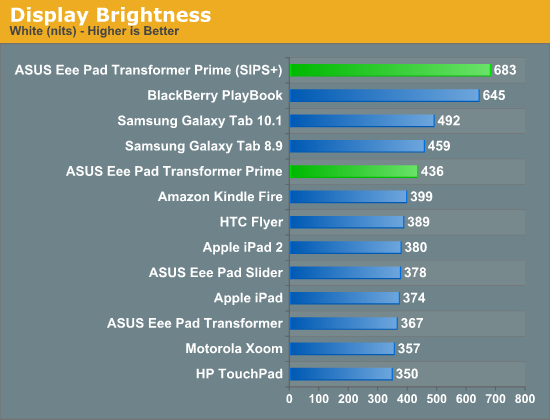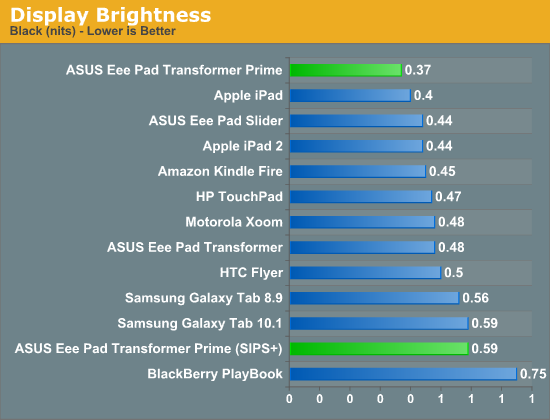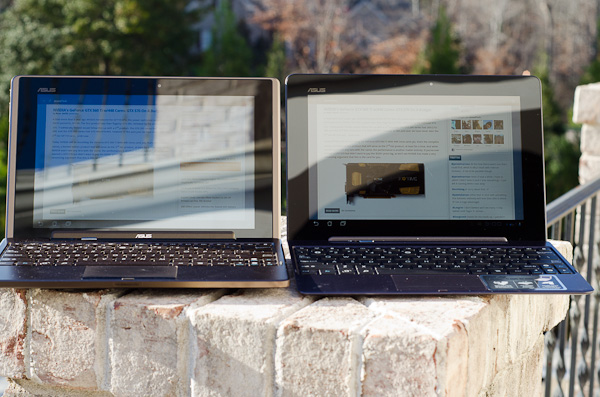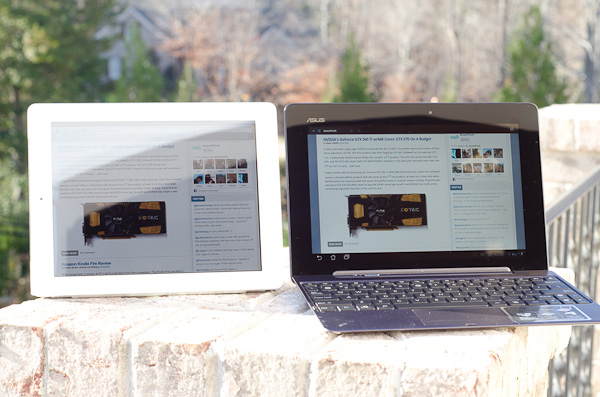ASUS Eee Pad Transformer Prime & NVIDIA Tegra 3 Review
by Anand Lal Shimpi on December 1, 2011 1:00 AM ESTThe Display: Perfect
The original Transformer had a display that performed similarly to the iPad, but was far more reflective thanks to a fairly large gap between the outer glass and the LCD panel underneath. I excused the first generation Eee Pad in the display department because it was good enough and $100 cheaper than the competing Apple solution. The Prime reaches price parity with the iPad 2, and as a result it must meet a higher standard. ASUS doesn't disappoint - the Eee Pad Transformer Prime has the best display I've seen on a tablet to date.
The resolution is a Honeycomb-standard 1280 x 800. The 16:10 panel measures 10.1-inches diagonally, giving it a very similar surface area to the iPad 2's 9.7-inch 4:3 display. The increase in resolution more than makes up for the larger screen however, ASUS delivers 145 pixels per inch compared to the iPad 2's now quite-dated ~132 PPI.
It's not all about pixel density here, the Transformer Prime has better white and black levels than anything else in its class. It also sets the new benchmark for contrast ratio at nearly 1200:1. The huge gap between the outermost glass and the IPS LCD panel has been reduced significantly, in turn reducing glare.



ASUS also has a Super IPS+ mode that drives the display to a class-leading 683 nits. The Super IPS+ mode obviously draws more power but ASUS recommends it if you're trying to use your tablet outdoors. In our review of the PlayBook we found that 600 nits was really the cutoff for usability in sunny conditions, and ASUS easily exceeds that. It's also worth pointing out that while Super IPS+ increases black levels as well, the resulting contrast ratio remains the same.

Original TF (left) vs. Super IPS+ enabled on the TF Prime (right)

iPad 2 (left) vs. Super IPS+ enabled on the TF Prime (right)
Viewing angles are absolutely awesome. Yes this is the same ASUS that let us down with the UX panels but it definitely got the panel right when it came to the Transformer Prime. Fingerprints are still going to be evident on the display but they don't seem to be as bad as on the original Transformer, and they do wipe off easily. This time around ASUS bundles a microfiber cloth to aid in keeping your Transformer looking fresh.
ASUS, Apple and the rest of the tablet world are in hot pursuit of even higher resolution panels, the problem is yields on these small 1080p and 2048x1536 panels just aren't high enough yet. The Android crowd will have to wait, although Apple is apparently pushing very hard (and trying to buy up a lot of inventory) to deliver a "retina display" equipped iPad 2+/3 by Q2 next year. I'm hearing Q3/Q4 for everyone else and it's still not a guarantee that Apple will be able to meet its aggressive targets either at this point.










204 Comments
View All Comments
Mumrik - Thursday, December 1, 2011 - link
I get the feeling Anand didn't enjoy the 39 hour thing :)Btw:
"The resolution is a Honeycomb-standard 1280 x 752. The 16:10 panel measures 10.1-inches diagonally,"
Huh? 1280x752?
That's not a 16:10 resolution...
Anand Lal Shimpi - Thursday, December 1, 2011 - link
It's technically 1280 x 800, the 752 is what you get when you remove the Honeycomb nav bar.mwildtech - Thursday, December 1, 2011 - link
Great Review Anand! Much better than Engadget's. We are lucky we still got nice sunny skies in Raleigh!SpacemanSpiff13 - Thursday, December 1, 2011 - link
Awesome review, Anand. I already had one preordered, but your review makes me really comfortable about my impulse buy, and it's not just a play for page clicks. Really solid, in-depth. Thanks.jwcalla - Thursday, December 1, 2011 - link
very well done reviewjjj - Thursday, December 1, 2011 - link
Nice to see a decent tablet and glad they didn't dropped (like some nutjobs) the microSD slot.Asus should really sell the keyboard much cheaper would help them gain considerable market share and maybe make one without the battery for 50-70$.And ofc bundle realVNC or Logmein with it.
TrackSmart - Thursday, December 1, 2011 - link
I agree that a cheaper keyboard option (or bundle w/ keyboard) would help sales.Regarding a version without the battery: the thing is already dangerously top-heavy when plugged into the dock. Can you imagine how bad it would be without the weight of the battery in there? They'd probably have to put some kind of weight near the front edge. Or use a design that connects the tablet further inward on the dock, as has been done on other tablets, which would ruin the laptop-like aesthetic (which is pretty nice).
Just my 2 cents.
jjj - Friday, December 2, 2011 - link
I was aware of that problem and amusingly enough i was also thinking about the same 2 solutions..The version without battery would be just to bring the price down a lot.The battery costs 20-25$ and that adds 40-70$ to the retail price so it would make a big difference.joe_dude - Thursday, December 1, 2011 - link
Personally, I'm not so interested in comparisons to the iPad. What I really want to know is how it compares to a tablet + netbook/ultrabook/MBA???If it can do a decent job in both roles, then it would really make life easier. Wouldn't need to sync files or deal with two different OSes. Save time and money.
Anand Lal Shimpi - Thursday, December 1, 2011 - link
Better than a netbook (what isn't? :-P) but not as good as an ultrabook/MBA for getting actual work done.Take care,
Anand